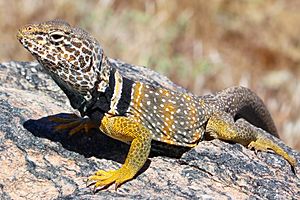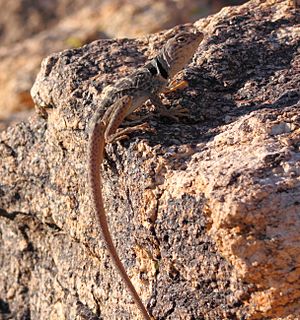Great Basin collared lizard facts for kids
Quick facts for kids Great Basin collared lizard |
|
|---|---|
 |
|
| Conservation status | |
| Scientific classification | |
| Genus: |
Crotaphytus
|
| Species: |
bicinctores
|
 |
|
| Great Basin collared lizard range | |
| Synonyms | |
|
|
The Great Basin collared lizard (Crotaphytus bicinctores) is a fascinating type of lizard. People also call it the desert collared lizard or the Mojave black-collared lizard. This lizard lives only in the Western United States, which means it is endemic to that area.
It looks a lot like the common collared lizard (Crotaphytus collaris). They are similar in shape and size. However, the Great Basin collared lizard does not have the same bright colors. Male lizards can be brown or orange, sometimes with red or pink on their bellies. Females are usually black or dark brown. This lizard has long scales near its claws. Its tail is more triangle-shaped, unlike the round tail of the common collared lizard.
What Does It Look Like?
The Great Basin collared lizard has a wide head and strong back legs. It gets its scientific name, bicinctores, from the two black bands around its neck. These bands look like collars!
Male lizards have wider heads than females. Their throats are often dark, and they have clearer orange bands across their bodies. Adult lizards are usually 2.5 to 4.5 in (6.4 to 11.4 cm) long from their snout to the base of their tail. Their thick tail is often twice as long as their body.
Where Do They Live?
The Great Basin collared lizard lives only in the Western United States. You can find it in California, most of Nevada, southeastern Oregon, southern Idaho, and parts of Utah and Arizona.
These lizards usually live in rocky areas of dry deserts. They are most common in places with desert shrubs and dry riverbeds. You can find them across the Mojave Desert, Sonoran Desert, and the southeastern Great Basin Desert.
What Do They Eat?
Crotaphytus bicinctores mainly eats arthropods, like insects and spiders. But these lizards also have strong jaws! They can use them to eat small animals with backbones. This includes other lizards, snakes, and even small rodents. Sometimes, they might even munch on plants.
See also
 In Spanish: Lagarto de collar de la gran cuenca para niños
In Spanish: Lagarto de collar de la gran cuenca para niños




